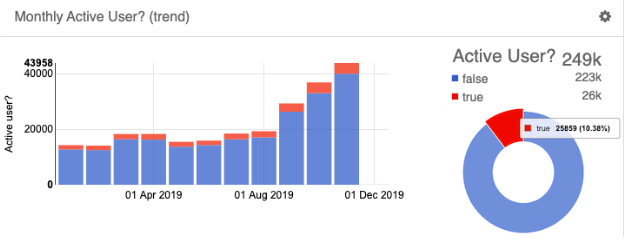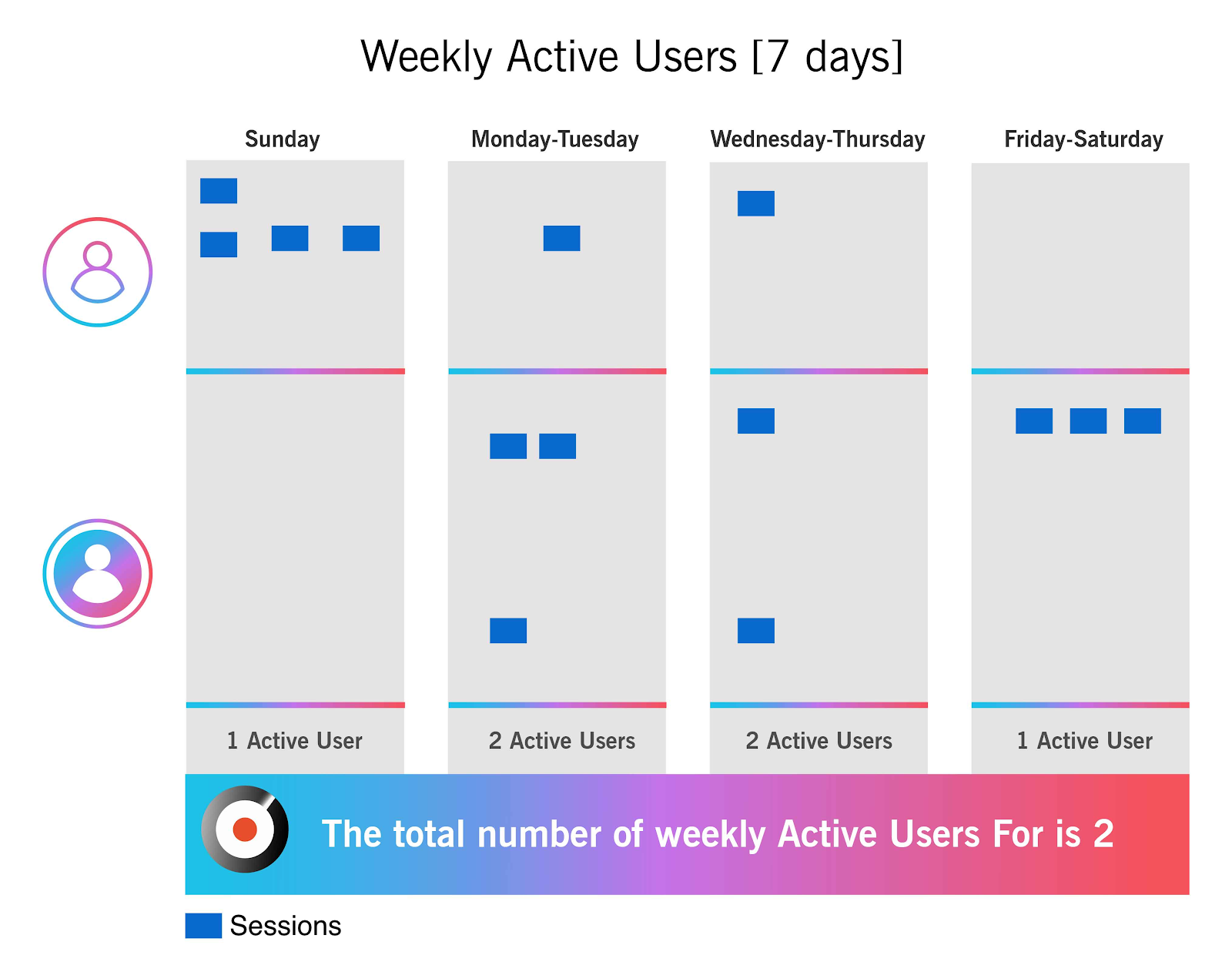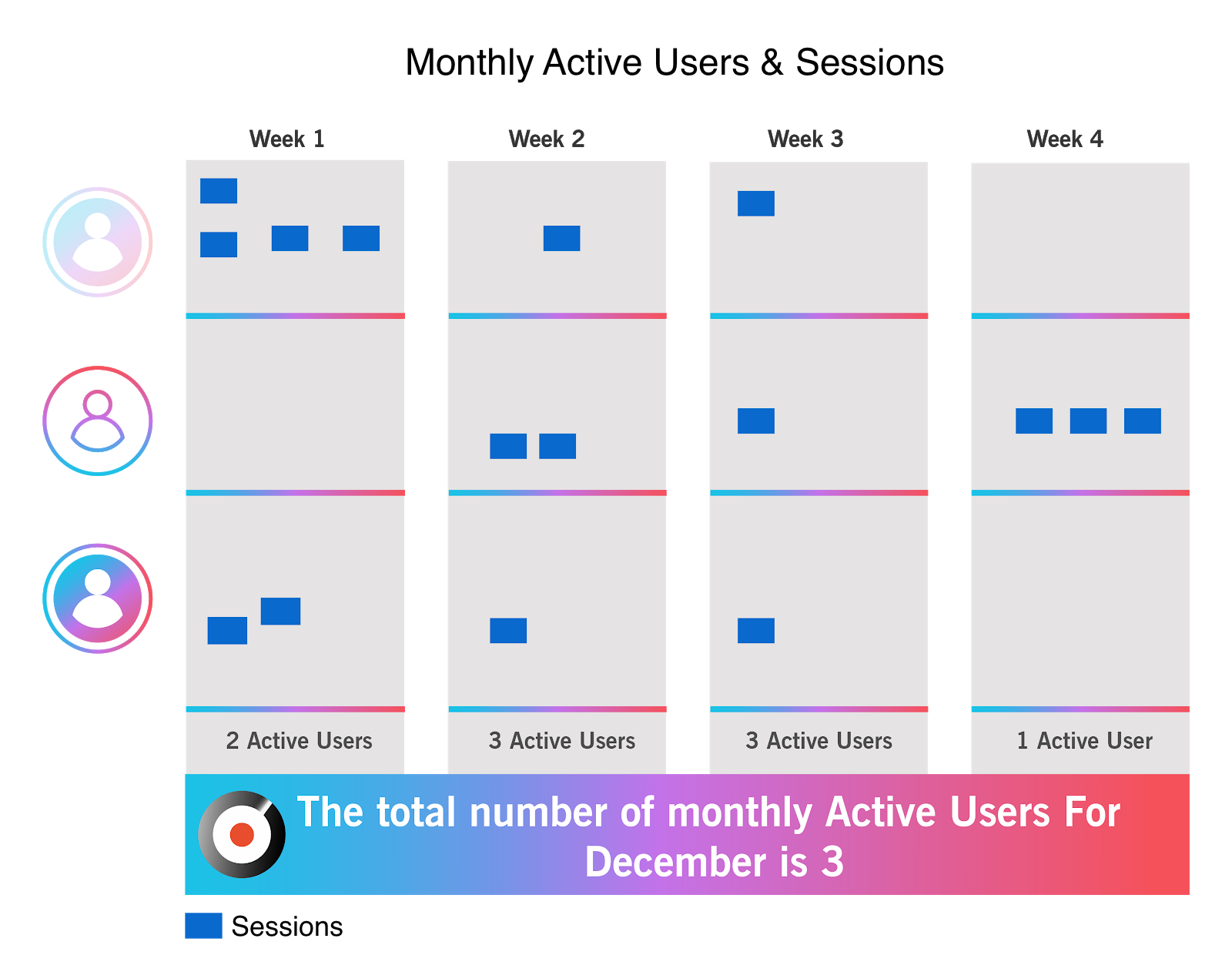Active Users: How To Measure It
(and everything You Need To Know).
What are active users?
Active users are the unique users that visit or interact with your website or your app (by using one or more of its available features) over a given interval.
The features an active user interacts with depends on the company and the kind of services offered.
For example
- Online banking application -> Making a transfer.
- Ecommerce -> Adding to cart.
- SaaS -> Using the software.
Active users are recognized with a personal unique identifier, this could be their email, id, cookies or a combination of all, in case one fails. This is done to avoid double counting of a user.

Types of Active Users.
There are two types of active users; New Users and Returning Users.
- New Users: These are the users that are visiting a website for the very first time.
- Returning Users: These are users that have visited a website in the past and are visiting again.
Why should you measure your active users?
Some may consider it a vanity metric, but I’d tell you this, every company should have a solid goal to reach as many eyes that fit into your buyer personas, to build a strong user base, brand authority and loyal supporters.
But how do you measure the effectiveness of your marketing efforts and the user experience of your product/service?
Well, knowing the number of active users you have is a vital step towards that goal.
For example,
When you measure your active users, you can determine key performance metrics like your churn rate and customer retention rate, and the lifetime value of your customers cannot be calculated without knowing your retention rates, and customer retention rates rely on discovering whether users are active over time.
So plainly, the number of active users provides a measure of the general fitness of the business and serves as a basis to calculate more informative metrics.
Like Andrew Chen, Angel Investor said:
“I would argue that the single most telling metric for a great product is how many of them become dedicated, repeat users.”
So why ignore it?
What you should know before measuring your Active Users!
The first thing you should realize is that how you measure active users heavily depends on the long term growth goals of your company.
For instance – Let’s say KIRA is a startup eCommerce store that uses 100% reusable materials for their products.
KIRA’s main aim right now is to create awareness, and the best way for them to measure their active users would be to measure number of unique people that view/login to their site or mobile app.
While another eCommerce store, YAni sells similar products with 100% recyclable materials, but have been in the game longer than KIRA.
YAni’s main aim at this point is to get more sales, their Active User (AU) measurement would be the number of unique users that add to a cart or make a purchase from their website or mobile app over a given period.
So, if a visitor does not add to cart or make a purchase from the website or app of YAni, they might be considered an inactive user.
You, therefore, have the power to decide what action makes a user “Active” according to your company’s growth goal.
Here is a table showing how different the measurement of active users can be, it’s up to the vision of your company and CEO to determine how to define what “active users” means. Here are some examples:
| Name of the Company. | Industry/What they do | Growth goal of the company. | Action taken before you’re considered an Active User |
| KIRA | Recyclable Products eCommerce | Create more awareness | Number of unique views/ logins on their website. |
| YAni | Recyclable Products eCommerce | Acquire more Sales | Number of unique persons that add to cart or buys from their store. |
| Kelp | Donation platform for Disabled kids | To reach their monthly goal of $10,000 | Number of unique persons that donated or shares their website link to others. |
| Aqua | A platform to get volunteers to help pick up plastic | To get 400 new volunteers | Number of unique people that sign up to be a volunteer or shares their link. |
But are you limited to having just one goal when calculating your active users?
No.
You can have two, three or even four growth goals.
For example:
Let’s say a start-up eCommerce, KIRA has grown in awareness and now, they want more sales but they’re also aiming for new leads.
Meaning they have two growth goals.
All they have to do now is decide what action suits each goal like this;
| Name of the Company. | Industry/ What they do | Growth goal of the company. | Action taken before you’re considered an Active User |
| KIRA | Recyclable Products eCommerce | Create more awareness | Number of unique views/logins on their website. |
| Acquire more Sales | Number of unique persons that add to cart or buys from their store. |
If 200 unique people create an account or log in to their site but only 50 unique users add to cart or make a purchase from their store, their Active Users according to their sales goal (ie acquire more sales) would be only 50, but their active users according to their awareness goal would be 200.
You can segment your audience according to what they do and what goal their actions or inactions helps you achieve.
The sine qua non to this is using the appropriate action for the goal it fits.
Once you figure out the exact goal(s) you’re aiming for, you can then proceed to measure your active users and progress towards your goal.
How to measure Active Users.
There are three main ways to measure active users in a given period. They include;
- Daily Active Users [DAU].
- Weekly Active Users [WAU].
- Monthly Active Users [MAU].
Daily Active Users.
DAU is a term used for the total number of unique people that take action within your website or mobile app on a given day.
Always have in mind that “Take action” is very relative, it depends heavily on the kind of company and its goals.
If you run a SaaS used for scheduling meetings and your long term goal is to get over 10,000 people to schedule meetings through your site,
Your DAU would be;
The number of unique users that make use of your software to schedule a meeting on a given day.
Anyone that logs in without scheduling anything will be considered an inactive user.
Whereas if you aim is to get views on your site, the unique amount of individuals that log into or visits your site will be considered as active users.
If a single user visits your app or website more than once a day. They are counted as 1 active user when calculating your DAU because it is the number of unique users that visit or perform an action.

Measuring your growth goal with the DAU method can be very misleading.
This is because it’s a very short amount of time to calculate accurately your retention rate and to know if the unique visitors are clients or even prospects.
You could have 20,000 unique visitors in one day and by the end of the month, the actual number of people engaging with your product/service (ie return users) could be drastically low. This can be very disheartening.
This can be as a result of an increase in your churn rate (he percentage rate at which customers stop subscribing to a service). Here are some of the reasons for the rise in your churn rate.
Regardless of this, Your DAU can still be meaningful, keep on reading to find out how.
Weekly Active Users.
WAU is the total number of unique users that view/engage with your website or mobile app within the last 7days, starting on the designated day.
If you have 10 unique visitors from Monday to Saturday and on Sunday, you lose 2 but the rest come back.
Your WAU would be 10.
The reason being, as long as they visited/engaged at least once within 7 days they are considered to be an active user for that week.

Monthly Active Users.
MAU shows the total number of unique individuals that view, log in or interact with your website/mobile, by sharing it or engaging with the features on it at least once within 30 days.
The MAU is a key metric because you can use this as an indicator of a healthy growth trajectory for your company. It shows a picture of how many returns and new users your company has.

User Engagement
The best way to use these metrics to determine your user engagement more effectively would be by
The DAU/MAU Ratio:measures how many days an active user engaged with your product within a period of 30days.
It calculates the stickiness of your product – that is, how often people engage with your product. It is commonly called the Measure of “Stickiness”.
It is expressed as:
DAU/MAU * 100
Example 1:
If your DAU is 50,000 on the first day of the month and your MAU is 100,000 unique users
Your Measure of Stickiness would be 50,000/100,000 * 100 = 50%.
This would mean that the average user of your website visits it 15 out of 30 days that month. I.e 50/100 * 30 = 15.
Example 2:
If your DAU is 700,000 and MAU is 3,000,000
Your measure of stickiness would be
700,000/3000000 * 100 = 23.3%
That means the average user of your service returns to your website or app 7 days out of 30 days.
More on measuring stickiness!
Conclusion
The ability to segment your audience is valuable. You can discern between two or more groups of active users, those that are clients and those who are prospects.
You may be worried that when measuring your active users it would be difficult to figure out why some users are active and others decide to leave.
That’s great thinking, the pressure will keep you alert and on your toes!
When using a tool like Opentracker, you’re in the know of everyone that has visited your website, what they browsed, from the very first time to the last, you get a good grasp of why the return users keep coming back and why your lost users leave.
Having the right metrics at hand will help your company understand how best to engage with prospects who have viewed your services or products and how to retain your existing customers.
Hereby, improving your customer retention rate and the overall growth of your company.
And don’t you want to know that?
Fill out this form to apply for a free consultation session with OpenTracker and find out how relevant & accurate analytics can help grow your business.
Author : Vera Agiang
Vera Agiang is an Experienced Marketing Specialist with a demonstrated history of working with B2B FinTech and Saas companies. Follow her on LinkedIn.
About us
Quick links
Resources
Contact
| support@opentracker.net | |
|
Opentracker Torenallee 45 - 7.17 5617 BA Eindhoven The Netherlands |